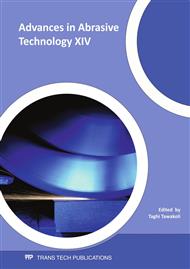p.557
p.563
p.570
p.576
p.582
p.588
p.594
p.600
p.606
Fabrication and Characterization of High Quality Micro Diamonds by Hot Filament CVD
Abstract:
The high quality micro diamonds with the euhedral diamond faces are fabricated by hot filament chemical vapor deposition technique (HFCVD). The high pressure and high temperature (HPHT) single crystal diamonds in size of 1 μm are used as seeds. In order to disperse the diamond seeds uniformly on a silicon wafer, the photoresist solution with diamond seeds are performed on the silicon wafer by a spin coater machine. The high substrate temperature and low acetone concentration are employed for decreasing the nucleation rate and accelerating the growth rate. The morphology and quality of the micro diamonds are observed and analyzed by SEM and Raman spectroscopy. After 4 hours of the deposition, the surface imperfections of the diamond seeds have disappeared completely, and the euhedral diamond faces with (111) and (100) begin to emerge. Subsequently, 8 hours of deposition leads to a final average size of approximately 4 μm. The micro diamonds have very high quality, and the surfaces appear flat and smooth in this stage. The results indicate that it is an effective way to eliminate the defects of the HPHT micro diamonds and develop high quality diamonds with well-defined morphology by HFCVD technique.
Info:
Periodical:
Pages:
582-587
Citation:
Online since:
August 2011
Authors:
Price:
Сopyright:
© 2011 Trans Tech Publications Ltd. All Rights Reserved
Share:
Citation:


